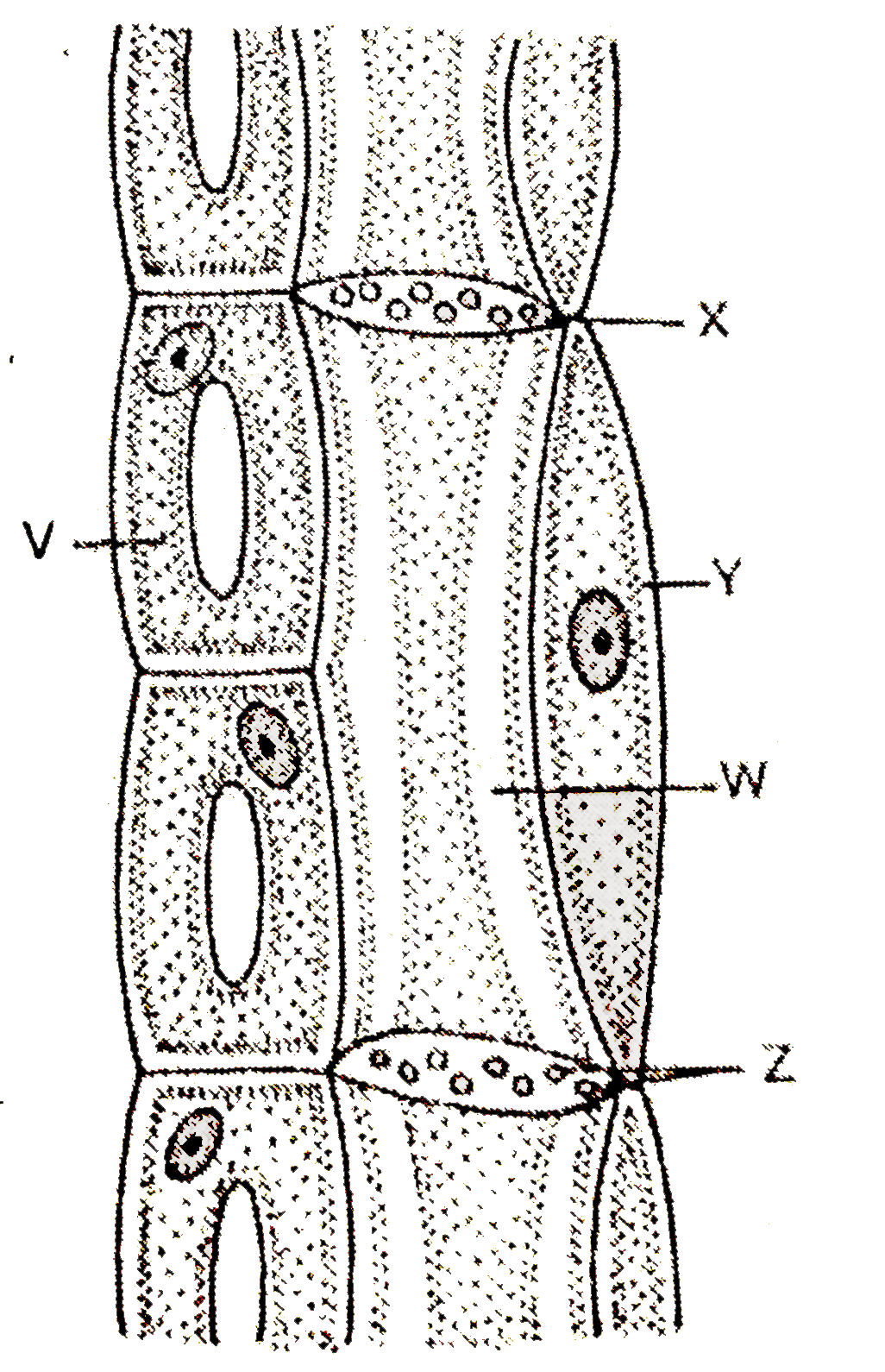Sieve tube cells of phloem tissue do not possess nuclei in mature state. Still they remain alive. Give the reason.
Step-by-Step Solution:
1. Understanding Sieve Tube Cells: Sieve tube cells are specialized cells found in the phloem tissue of plants. They are responsible for the transport of nutrients, particularly sugars, throughout the plant.
2. Lack of Nuclei: In their mature state, sieve tube cells do not possess nuclei. This is unusual for living cells, as the nucleus is typically essential for cell function and survival.
3. Dependency on Companion Cells: Despite lacking nuclei, sieve tube cells remain alive because they are closely associated with companion cells. Companion cells are living cells that have nuclei and perform vital functions.
4. Role of Companion Cells: Companion cells provide the necessary support to sieve tube cells. They gather nutrients and other essential substances, which they then supply to the sieve tube cells.
5. Cooperative Functioning: The relationship between sieve tube cells and companion cells is crucial for the survival of the sieve tubes. They work together to ensure the transport of nutrients, with companion cells facilitating the metabolic needs of the sieve tube cells.
6. Conclusion: Therefore, sieve tube cells can remain alive without nuclei because they rely on the companion cells for their metabolic functions and nutrient supply.
---
Topper's Solved these Questions
- BOOK - MTG IIT JEE FOUNDATIONCHAPTER - TISSUES EXERCISE - NCERT SECTION20videos
TISSUES
- BOOK - MTG IIT JEE FOUNDATIONCHAPTER - TISSUES EXERCISE - EXERCISE (Multiple Choice Questions (LEVEL - 1))30videos
TISSUES
- BOOK - MTG IIT JEE FOUNDATIONCHAPTER - TISSUES EXERCISE - Olympiad /HOTS Corner15videos
TISSUES
- BOOK - MTG IIT JEE FOUNDATIONCHAPTER - NATURAL RESOURCESEXERCISE - Olympiad/HOTS Corner11videos
NATURAL RESOURCES
- BOOK - MTG IIT JEE FOUNDATIONCHAPTER - WHY DO WE FALL ILL?EXERCISE - OLYMPIAD/HOTS CORNER10videos
WHY DO WE FALL ILL?
Similar Questions
Knowledge Check
- Question 1 - Select One
At maturity, sieve tubes do not possess –
ACell wallBNucleusCCytoplasmDVacuoles - Question 2 - Select One
Refer to the given dichotomous key and answer the following questions.
I. (a) The cells of tissue have walls. - Go to II
(b) The cells of tissue do not possess wall. - Go to III
II. (a) Tissue made of one type of cells. - Go to IV
(b) Tissue, made of more than one type of cells. - Go to V
III. (a) The tissue lines the alveoli of lungs. -P
(b) The tissue forms shock absorbing cushion around some vital organs. - Q
IV. (a) Cells of tissue contain air cavities and it provides buoyancy. -R
(b) The tissue provides mechanical strength and flexibility to young dicot stems and petioles. - S
V. (a) Tissue conducts water. - T
(b) Tissue conducts organic solutes. - U
Select the incorrect option regarding tissues P, Q, R, S, T and U.AP is an epithelial tissue whereas Q is a loose connective tissue.BT is either greatly reduced or absent but R is exclusively present in aquatic floating plants whereas S is found in Cucurbita stems.CR is aerenchyma, S is collenchyma, T is xylem and U is phloem.DU is found in grit of guava, pear, etc., whereas the matrix of tissue P contains a flexible material called chondrin. - Question 3 - Select One
A tissue made up of only one type of differentiated cells is
AP is an epithelial tissue whereas Q is a loose connective tissue.BT is either greatly reduced or absent but R is exclusively present in aquatic floating plants whereas Sis found in Cucurbita stems.CR is aerenchyma, S is collenchyma, T is xylem and U is phloem.DU is found in grit of guava, pear, etc., whereas the matrix of tissue P contains a flexible material called chondrin.
Do all the single electron species of various ele- ments possess same energy for the electron in the ground state? Give reason.
View SolutionCells without nuclei cannot survive for a longer period. Give reason.
View SolutionCamels can remain alive without food for many days. Give reason.
View SolutionClusters of egg cells are not considered as tissue. Give reason.
View SolutionThe generative cell of a two celled pollen divides in the pollen tube, but not in a three-celled pollen. Give reasons.
View Solution


